A self-study, self-paced course where you can learn how to paint in watercolor by watching video lessons and doing assignments
$297 USD
ENROLL NOWA self-study, self-paced course where you can learn how to paint in watercolor by watching video lessons and doing assignments
$297 USD
ENROLL NOWOne-to-one, unlimited and custom-tailored to your skills and needs Personal Tutoring by the Watercolor Academy teachers
$997 USD
ENROLL NOWVideo lesson by Vladimir London
In this video, you will discover how to make an intricate pattern illustration.
Here is the artwork we will get by the end of this video lesson.
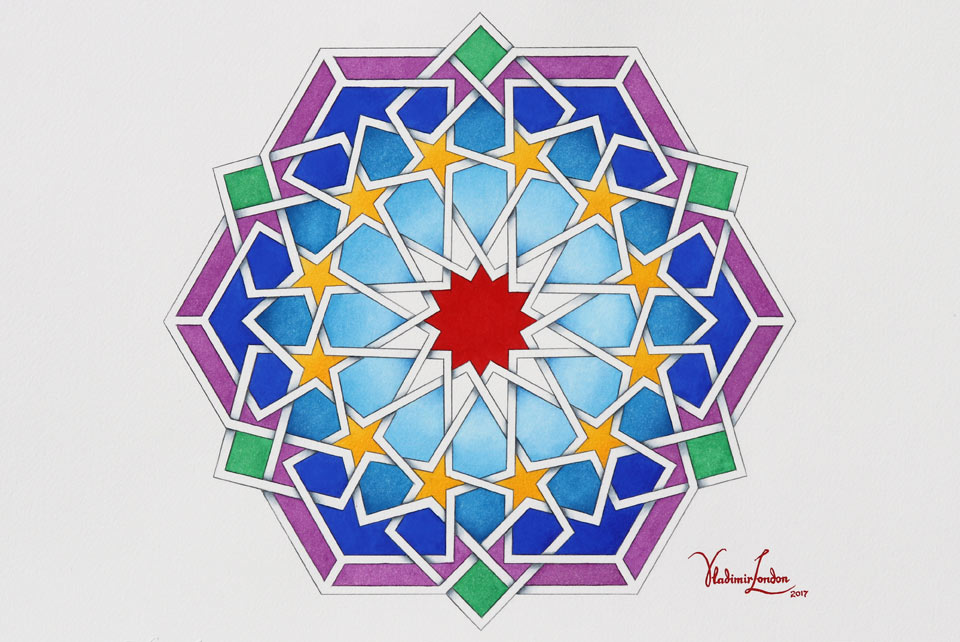
I will make this illustration on 100% cotton paper, which is 'Cold-pressed', and has a weight of 300gsm. The pattern consists of interlocking geometrical shapes with straight lines, so I am using a ruler to transfer the drawing. The preliminary artwork was done on the tracing paper, and because it is fully symmetrical, I can turn over the tracing paper and transfer it line-by-line onto the watercolor paper.
The design is quite intricate, and in order to avoid a lot of erasing, it is better to draw on the tracing paper first, and then transfer the finished design. All lines here are rather bold; this is good, because they will be an integral part of the artwork. When the drawing is done, it is time to decide on colors. I have to pick only six colors for the job. This is when self-made color swatches become very handy. The first color is French Ultramarine, and I also use Cadmium yellow, green and purple colors. In addition, Windsor red and Windsor blue green-shade colors can be added.
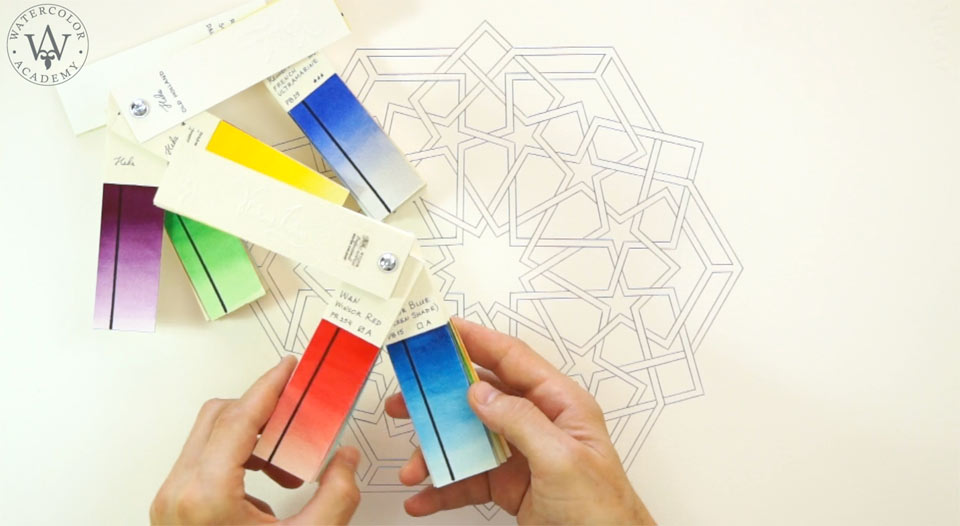
It is a good idea to test the chosen colors on a separate piece of watercolor paper, in order to see how they compare with one another and look together. I would like to test the difference between Cadmium yellow and Cadmium yellow deep. When you make color swatches, you should put the paint names next to them – this is especially helpful for future reference.
As suggested by its name, the Cadmium yellow deep has a deeper color than the Cadmium yellow, so I will use it for this artwork. Cadmium yellow deep comes with a richer and darker color because, in addition to the yellow pigment (PY35), it also contains a little bit of orange pigment (PO20). Be aware that various manufacturers may use different names for the same paint, and even more confusingly, the same name can be used for watercolor paints that contain different pigments. Therefore, it is better to check not only paint colors, but also which pigments they are made of. Nevertheless, when different manufacturers produce watercolor paints with the same name and the same pigment, it does not guarantee that the same paints will have exactly the same colors. Colors may differ slightly from manufacturer to manufacturer. That is why I make and keep a collection of color swatches of every watercolor paint that I have at my disposal.
The purpose of this lesson is to learn how different colors look in one artwork, and also to practice paintbrush handling, by accurately filling different shapes with uniform-tone single color. We want to make a beautifully-looking composition of different colors, and to develop the skill of filling different shapes with paint without visible brushstrokes.
In this pattern, the yellow color will only be used for stars. There won't be any other yellow elements here. You may notice that I place a paper tissue under the hand to protect the watercolor paper. I will now paint the star in the middle in a red color. This is a single pigment paint. PR254 is a very intense red pigment; unfortunately, not many manufacturers produce such a red paint. One of them is Windsor & Newton. This paint is very lightfast, which means that it will not fade after being exposed for thousands of hours to direct sunlight or UV light. Also, it is highly staining and semi-opaque, and has a small drying shift, meaning that the hue of the color and its value will both not change much when the paint dries.
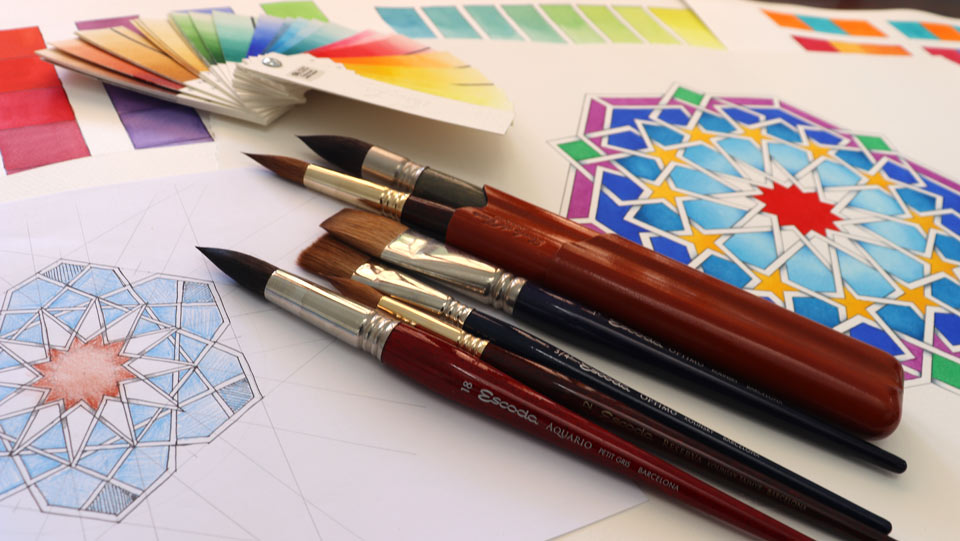
I am painting with the Kalinsky-Sable round brush from Escoda. The star in the middle is the only red element in this design. It is time to now add the blue color, which is the Windsor blue green-shade from Windsor & Newton. PB15 pigment, also called Phthalo blue, is a deep intense blue with a green undertone. The tinting strength of Phthalo blue is very high; when it is mixed with other paints, it will overpower most of the pigments, meaning that a tiny amount of this pigment will go a long way. The Phthalo blue has a very large drying shift; when this paint dries, it will lose more than 20% of its saturation. Even after washing the brush in clean water, the pigment is so strong that it still stains the paper. When the paper is wet, it is easier to make a gradation of color. I am adding the blue paint in one corner, and then spread it out to fill the remaining space; this way, one side is a bit darker than another. I am using a short natural-hair flat brush from Escoda to do this task.
Accurately filling the geometrical pattern is quite a time-consuming job, and it requires accurate brush strokes to stay within the lines. Identical design elements are repeated several times in this pattern. The task is quite simple - to fill in geometric shapes with the same color and tone. I repeat this 12 times to complete the pattern, and for you to not get bored, I will fast-forward this process to the step where the blue shapes are already painted. As you can see, this is a rather mechanical task, and a good exercise to train your brush handling skills. I will paint the next element of the geometric pattern with Ultramarine. This blue pigment has a slightly different color to the phthalo blue. It is slightly colder and will look quite nice in combination with yellow stars. I fill this shape in plain tone without any gradation.
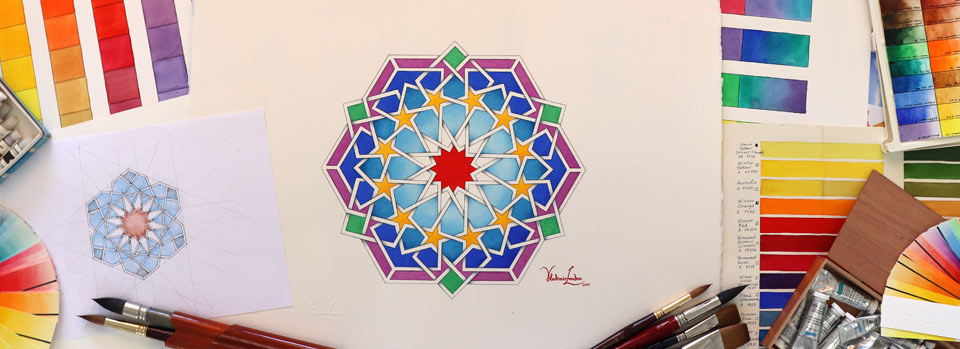
Next to this six-sided shape, there is another intricately-shaped cell, which I fill with blue Ultramarine as well. This type of mechanical job requires a bit of patience, but is a good exercise to keep all shapes in the same tone. The next paint I use is Quinacridone Violet. This pigment has a vivid violet color with a pink undertone (the code of this pigment is PV55). This paint is transparent and permanent. I use it to color the band around this pattern. This violet color looks nice next to the blue Ultramarine color. Because it is quite dark, I am diluting this pigment to make it lighter.
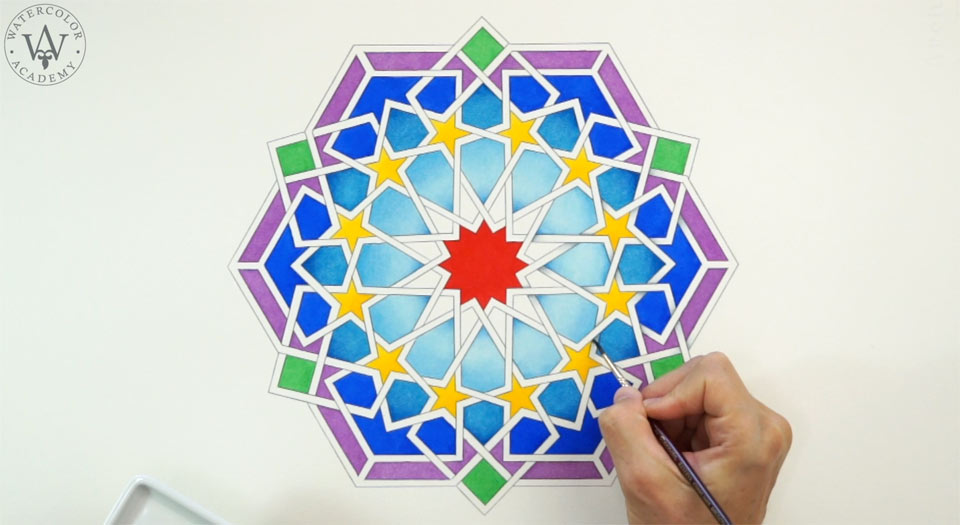
The final paint which I am using for this design is 'yellowish-green' from Saint-Petersburg manufacturer. This paint is made of two pigments – yellow and green – and has quite a bright color and light tone. So far, this design looks a bit flat. To enhance its appearance, I add drop shadows to some elements. To make such shadows, I first apply clean water with a flat, small brush, and then add more blue pigment with a small, round brush. I do this only in the corners, so that they look darker and a bit more three-dimensional.
A self-study, self-paced course where you can learn how to paint in watercolor by watching video lessons and doing assignments
One-time payment - Lifetime membership
$297 USD
One-to-one, unlimited and custom-tailored to your skills and needs Personal Tutoring by the Watercolor Academy teachers
One-time payment - Lifetime membership
$997 USD